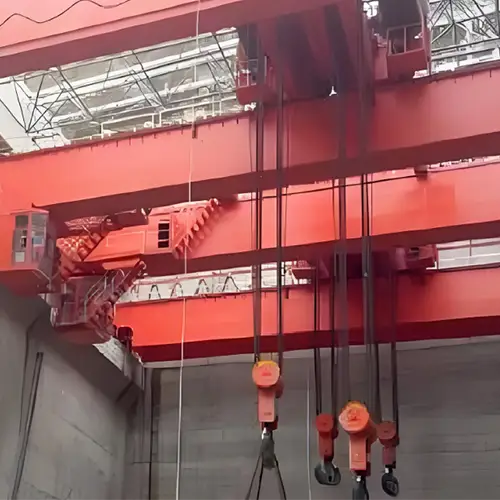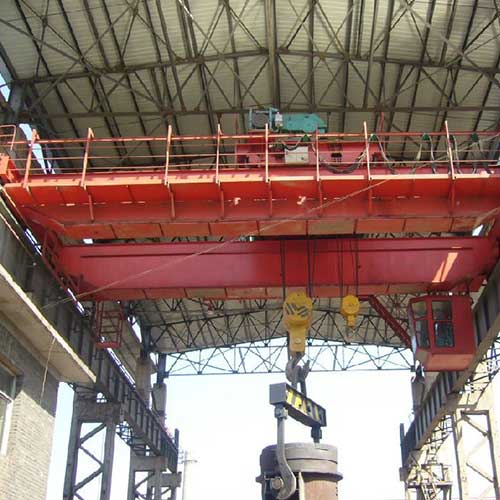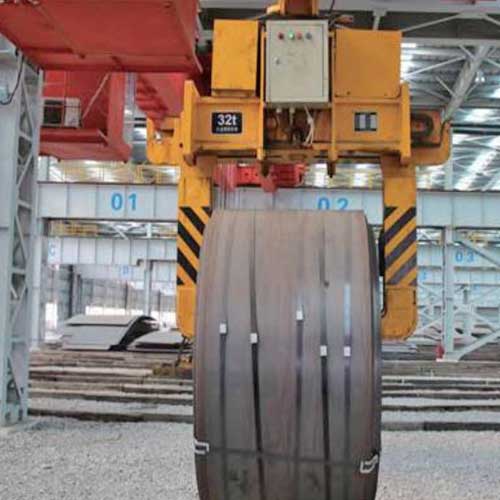Heavy Duty Overhead Crane 32 to 500 Ton Lightens Financial Load
Heavy duty overhead crane for sale. Heavy-duty overhead cranes 32 to 500 tons are vital tools in various industrial uses. Get your heavy duty crane design!
Category: Heavy Duty & Large Capacity
Your Trusted Heavy Duty Overhead Crane Manufacturer & Supplier
Heavy Duty Overhead Crane 32 Ton to 500 Ton : Effortless Hoisting that Lightens Your Financial Load
Heavy Duty Overhead Cranes (32-500 Ton) for Heavy Load Handling in Demanding Industrial Applications
Heavy duty overhead crane for sale. Heavy-duty overhead cranes 32 to 500 tons are vital tools in various industrial uses. Get your heavy duty crane design! Heavy-duty overhead cranes, with lifting capacities ranging from 32 to 500 tons, are vital tools in various industrial sectors. Designed to handle exceptionally heavy loads, these cranes are engineered for robust performance and reliability. Their capability to lift massive weights makes them indispensable in environments where precision and safety are paramount, such as manufacturing plants, steel mills, and construction sites.
The importance of heavy-duty overhead cranes in demanding industrial applications cannot be overstated. They enhance operational efficiency by streamlining the movement of heavy materials and equipment, reducing the need for manual labor, and minimizing the risk of workplace injuries. These cranes are not only capable of lifting large loads but also offer advanced features that ensure smooth and safe operation in challenging conditions.
Overview of Heavy Duty Overhead Cranes
Heavy-duty overhead cranes are specialized lifting devices designed to transport substantial loads within industrial facilities. These cranes typically consist of a bridge that spans the width of the workspace, with a hoist mounted on the bridge to lift and lower loads. Their design is focused on providing efficient and safe handling of heavy materials, making them essential in various sectors.

Key Characteristics:
- High Load Capacity: Heavy-duty overhead cranes are engineered to handle weights ranging from 32 tons to 500 tons. This capacity makes them ideal for lifting heavy machinery, components, and raw materials.
- Durability: Constructed with high-strength materials, these cranes feature reinforced designs that enable them to endure the rigors of frequent heavy use. They are built to resist wear and tear from heavy loads and harsh environments, ensuring longevity.
- Precision Control: Equipped with advanced hoisting systems, heavy-duty cranes offer precise control for accurate positioning of loads. This capability is crucial for operations that require exact placements, reducing the risk of accidents and material damage.
Differences Between Heavy-Duty and Standard Cranes
While both heavy-duty and standard overhead cranes serve the purpose of lifting loads, there are significant differences that set them apart:
- Capacity: Standard cranes typically lift lighter loads, usually under 32 tons. In contrast, heavy-duty cranes are specifically built to handle much heavier weights, accommodating the needs of industries such as steel manufacturing, power generation, and shipbuilding.
- Construction: The construction of heavy-duty cranes involves more robust materials and engineering standards to meet rigorous operational demands. They are designed for high-frequency usage in challenging environments, which may include extreme temperatures, dust, and vibrations.
- Features: Heavy-duty cranes often include advanced safety features, such as overload protection, anti-collision systems, and customizable options tailored to specific industrial needs. Standard cranes may not offer the same level of versatility or advanced safety mechanisms, making heavy-duty options more suitable for high-stakes environments.
In summary, heavy-duty overhead cranes are vital for industries that require the lifting and transportation of extremely heavy loads. Their robust construction, high load capacity, and precision control set them apart from standard cranes, ensuring they meet the demanding requirements of various industrial applications.
Benefits of Using Heavy Duty Overhead Cranes
Enhanced Productivity and Efficiency
- Streamlined Operations: Heavy-duty overhead cranes significantly improve workflow by enabling the swift movement of heavy loads, which minimizes downtime and accelerates production processes.
- Higher Throughput: With their ability to handle large and heavy items, these cranes enhance overall throughput in manufacturing and other industrial operations.
Improved Safety and Reduced Manual Labor
- Minimized Risk of Injury: By automating the lifting and transportation of heavy materials, overhead cranes reduce the risk of workplace injuries associated with manual handling.
- Safety Features: Equipped with various safety mechanisms, these cranes ensure safer operations, fostering a more secure working environment.
Versatility Across Multiple Industries
- Wide Range of Applications: Heavy-duty cranes are adaptable to various sectors, including manufacturing, construction, power generation, mining, aerospace, shipbuilding, and automotive, making them invaluable tools for diverse operations.
- Customizable Options: Their design allows for customization to meet the specific needs of different industries, further enhancing their utility.
Overview of Heavy-Duty Crane Systems and Supporting Column Structures
Crane Systems
Heavy-duty overhead cranes operate as integral components of a comprehensive system designed for lifting and transporting heavy loads. The key elements of these systems include:
- Bridge: The horizontal structure that spans the workspace, providing a pathway for the hoist and trolley. Its design is critical for distributing weight evenly and ensuring stability.
- Hoist: This component is responsible for lifting and lowering loads. It must be engineered for high load capacities and equipped with precision control mechanisms to handle heavy and sensitive materials safely.
- Trolley: The trolley moves along the bridge, allowing for horizontal movement of the hoist. Its design affects the overall speed and efficiency of load handling.
- End Trucks: These are mounted at each end of the bridge and support the entire crane system, enabling it to traverse along the supporting columns. Their construction must accommodate the weight of the crane and the loads it lifts.
Supporting Column Structures
The stability and safety of heavy-duty cranes heavily depend on robust supporting column structures. Key features include:
- Load-Bearing Capacity: Columns are engineered to support significant weights, ensuring they can handle the dynamic loads generated during operation.
- Foundation Anchorage: These columns are typically anchored to the floor or foundation, providing additional strength and stability. This anchoring prevents movement and ensures safe operation, even under heavy loads.
- Design Considerations: The placement and design of supporting columns are meticulously planned to align with the specific lifting operations and layout of the industrial facility. Proper spacing and structural integrity are essential for optimal performance.
By understanding the fundamental aspects of heavy-duty overhead crane systems and their supporting structures, businesses can make informed decisions when selecting the right crane system for their unique lifting applications. This knowledge ensures optimal performance, enhanced safety, and efficiency in industrial operations.
Typical Designs of Heavy Duty Overhead Cranes

Electric Hoist Heavy Duty Overhead Crane
- Crane Feature: Utilizes an electric hoist for precision and control.
- Typical Applications: Known for reliability and efficiency in industrial applications, particularly in manufacturing and assembly environments.
- Advantages: Offers smooth operation and high lifting accuracy, minimizing the risk of damage to materials.
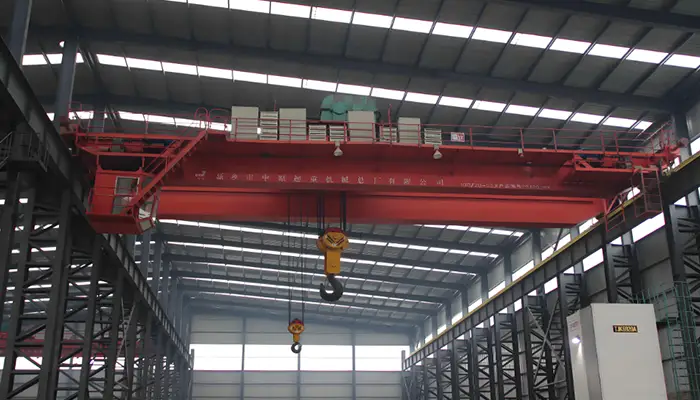
Open Winch Heavy Duty Overhead Crane
- Crane Feature: Features an open winch design for versatility.
- Typical Applications: Ideal for flexible lifting tasks in construction and manufacturing.
- Advantages: Allows for various lifting configurations and quick adjustments, enhancing operational efficiency.

Built-Up Hoist Heavy Duty Overhead Crane
- Crane Feature: Incorporates a customized built-up hoist for specific load requirements.
- Typical Applications: Suitable for applications with unique lifting needs, such as specialized manufacturing processes.
- Advantages: Offers tailored solutions that can handle diverse loads and operational demands.
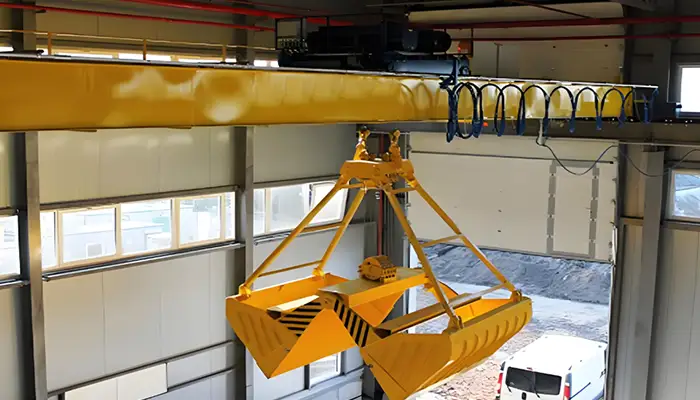
Grab Bucket Heavy Duty Overhead Crane
- Crane Feature: Designed for handling loose materials like scrap metal and aggregates.
- Typical Applications: Efficient loading and unloading for recycling facilities and ports.
- Advantages: Facilitates rapid material transfer and improves operational efficiency in bulk handling.
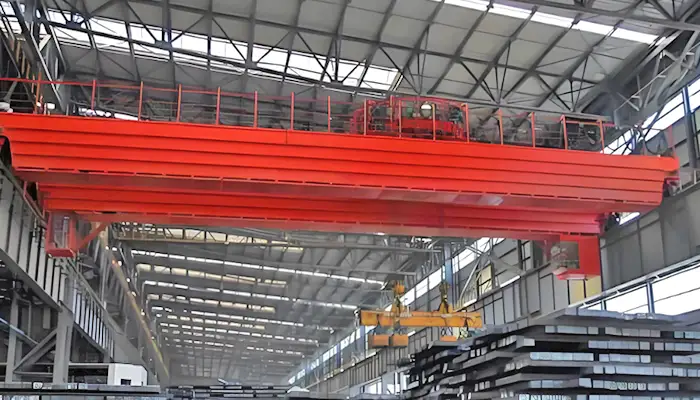
Magnetic Heavy Duty Overhead Crane
- Crane Feature: Features a magnetic lifting device for ferrous materials.
- Typical Applications: Beneficial for quick handling of heavy metal loads in environments such as steel mills and recycling centers.
- Advantages: Provides a secure grip on metal items, reducing the risk of drops and improving safety during operations.
These designs highlight the diversity of heavy-duty overhead cranes tailored to meet specific industry requirements, enhancing productivity and safety across various applications.
Hot Sale Capacity of Heavy Duty Overhead Cranes
- 10 Tons: With a 10-ton capacity, this crane is ideal for smaller manufacturing tasks and light industrial applications. Its compact design allows for operation in limited spaces, enhancing efficiency.
- 20 Tons: A 20-ton capacity crane is suitable for handling medium-sized machinery and components in manufacturing and construction. It offers a balance of strength and versatility for diverse lifting tasks.
- 32 Tons: This crane, with a 32-ton capacity, is commonly used in heavy manufacturing and steel industries for lifting larger components and equipment. Its enhanced stability and durability make it perfect for demanding operations.
- 40 Tons: With a 40-ton capacity, this crane is utilized in heavy industries for lifting large components, including machinery and structural elements. Its substantial lifting power contributes to efficient and safe operations in various applications.
- 50 Tons: A 50-ton crane is typically used in steel mills, power plants, and large manufacturing facilities for lifting extremely heavy loads. It features advanced safety mechanisms to manage significant weights securely.
- 75 Tons: This 75-ton crane is frequently employed in large industrial projects, such as shipbuilding and heavy equipment assembly. Its strong construction allows it to withstand rigorous operational demands.
- 80 Tons: An 80-ton capacity crane is ideal for the transportation of large structural components and equipment in heavy manufacturing and construction. Its enhanced lifting mechanisms improve overall efficiency.
- 100 Tons and Above: Cranes with a capacity of 100 tons and above are utilized in specialized sectors like aerospace and heavy manufacturing for ultra-heavy lifting tasks. Customizable options are available to meet unique industrial requirements.
Key Applications in Various Industries
Manufacturing
In the manufacturing industry, heavy-duty overhead cranes are essential for the efficient lifting and transportation of heavy machinery, components, and raw materials. Their presence significantly enhances productivity and safety on the production floor.
Key Functions
- Efficient Workflow
These cranes facilitate the rapid movement of large parts to and from workstations, effectively reducing downtime and improving overall operational efficiency. - Versatility in Handling
Heavy-duty cranes are capable of managing a wide array of materials, from metal sheets to large industrial equipment, making them indispensable across various manufacturing sectors.
Typical Types of Cranes Used
- Electric Hoist Heavy Duty Overhead Crane
This type provides precision and control for various lifting tasks, ensuring reliable performance in demanding environments. - Open Winch Heavy Duty Overhead Crane
Designed for flexibility, this crane allows for versatile lifting operations, adapting easily to diverse handling needs.
Steel Mills
Heavy-duty overhead cranes are vital in steel mills, managing the substantial weights of raw materials and finished steel products. These cranes facilitate critical tasks, such as charging furnaces with scrap metal and transporting molten steel.
Key Considerations
- High-Temperature Operations
Cranes in this environment must feature heat-resistant components to withstand extreme temperatures, ensuring reliable performance under harsh conditions. - Dust and Debris Management
Given the dusty nature of steel mills, cranes should be equipped with sealed electrical components to protect against damage and enhance safety.
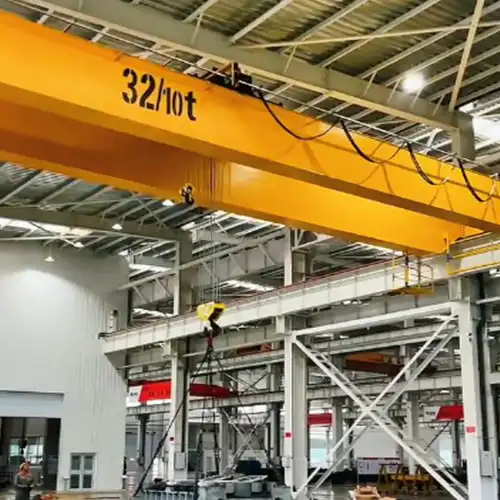
heavy duty overhead crane
Typical Types of Cranes Used
Charging Cranes
- Crane Feature: Built to handle heavy loads and designed for precise positioning during the charging of furnaces. Equipped with reinforced structures to endure operational stresses.
- Typical Loads Handled: Scrap metal and raw materials for furnaces.
- Advantages: Designed to endure extreme temperatures and harsh environments, ensuring safety and reliability.
Ladle Cranes
- Crane Feature: Equipped with specialized hooks or attachments for secure handling of ladles filled with molten metal. These cranes feature advanced safety systems to prevent spills and accidents.
- Typical Loads Handled: Molten metal, ensuring the safe and efficient transportation of ladles filled with liquid steel.
- Advantages: Critical for maintaining safe operations in high-temperature environments, providing robust stability during transport.
Billet Handling Cranes
- Crane Feature: Designed with specialized lifting mechanisms that allow for the secure handling of billets and slabs, often featuring enhanced maneuverability for tight spaces.
- Typical Loads Handled: Billets and slabs during various stages of steel production.
- Advantages: Ensures smooth movement throughout the production process, contributing to overall efficiency.
Coil Handling Cranes
- Crane Feature: Often equipped with specialized lifting devices such as C-hooks or magnets that facilitate efficient loading and unloading of coils.
- Typical Loads Handled: Steel coils, enabling transport within the mill and to storage areas.
- Advantages: Designed for versatility and ease of use, improving workflow and reducing manual handling risks.
Construction
Heavy-duty overhead cranes are indispensable in the construction industry, where they play a crucial role in lifting and positioning large structural components, such as beams and precast concrete elements. These cranes significantly enhance site productivity by facilitating quick and efficient material handling.
Key Considerations
- Adaptability to Site Conditions
Cranes must be selected based on specific site conditions, including the need for outdoor operation capabilities and the ability to navigate potential space constraints. Factors such as terrain, accessibility, and overhead clearance must be considered. - Load Capacity Considerations
The lifting capacity of the crane must align with the weights of various construction elements. Heavy-duty cranes should be capable of handling the significant loads of beams, concrete panels, and other large materials typically encountered on construction sites.
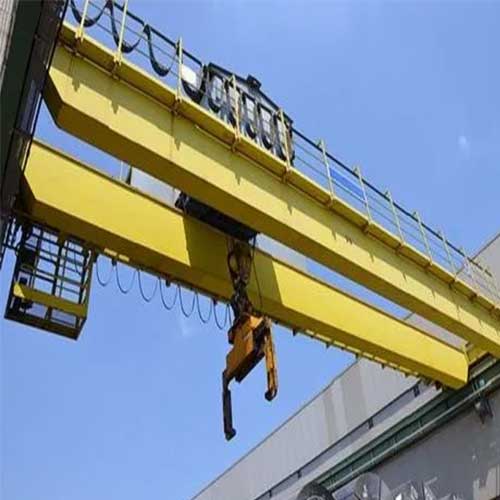
Typical Types of Cranes Used
Outdoor Overhead Crane Systems with Supporting Columns
- Crane Feature: Designed for outdoor use, these systems are supported by robust columns that provide stability while allowing for wide spans and heavy lifting capacities.
- Typical Loads Handled: Large structural components, machinery, and bulk materials.
- Advantages: Their design is tailored for outdoor environments, making them effective for construction sites with expansive space and the need for high lifting capabilities.
Heavy-duty overhead cranes are essential tools in the construction industry, enhancing efficiency and safety during material handling. By selecting the appropriate crane type and considering site-specific requirements, construction projects can achieve streamlined operations and improved productivity.
Automotive
In the automotive industry, heavy-duty overhead cranes are used to manage the production and assembly of vehicles. They play a significant role in lifting heavy machinery and finished vehicles, streamlining manufacturing processes.
Key Considerations
- Integration with Existing Workflows
The selected crane should fit seamlessly into the existing production line, enhancing overall efficiency. This integration is crucial for maintaining smooth operations. - Operational Efficiency
Heavy-duty cranes facilitate quick movements of components, reducing bottlenecks and improving throughput. This efficiency is vital for meeting production demands.
Typical Types of Cranes Used
Jib Cranes
- Crane Feature: Ideal for lifting lighter components within tight spaces, offering flexibility in operations.
- Typical Loads Handled: Lighter components such as engines, doors, and body parts, typically up to 5 tons.
- Advantages: Compact design allows for effective use in confined areas.
Overhead Bridge Cranes
- Crane Feature: Widely used for moving heavy vehicle parts along the assembly line, ensuring efficient workflows.
- Typical Loads Handled: Complete vehicle assemblies and heavy automotive parts, often ranging from 10 to 50 tons.
- Advantages: Their ability to cover large areas makes them essential for assembly operations.
In summary, heavy-duty overhead cranes are essential across various industries, providing critical support for handling heavy loads safely and efficiently. When selecting the right heavy-duty bridge crane, it's vital to consider the specific industrial conditions and operational requirements of each sector to enhance productivity and ensure safety.
Power Generation
In power plants, heavy-duty overhead cranes are essential for the installation and maintenance of heavy equipment, such as turbines and generators. These cranes play a crucial role in ensuring the safe handling of critical components, which is vital for the reliability of power generation.
Key Considerations
- Precision and Control
Cranes used in the power generation sector must provide precise movements to avoid damage to sensitive equipment. This level of control is necessary for tasks such as positioning turbines and generators, where even minor misalignments can lead to significant operational issues. - Safety and Compliance
Given the high-stakes nature of power generation operations, heavy-duty cranes must adhere to stringent safety regulations. Compliance with industry standards is essential to minimize risks and ensure safe operations throughout the facility.
Typical Types of Overhead Cranes Used
- Crane Feature: These cranes span across the entire width of the facility, providing comprehensive coverage for lifting operations.
- Typical Loads Handled: Heavy machinery and structural components essential for power generation.
- Advantages: Their design allows for efficient handling of large equipment, making them ideal for maintenance and installation tasks in power plants.
Electric Overhead Traveling (EOT) Cranes
- Crane Feature: EOT cranes are designed for precise lifting and moving within confined spaces.
- Typical Loads Handled: Equipment such as turbines, generators, and transformers, typically ranging from 10 to 100 tons.
- Advantages: Their ability to navigate tight spaces enhances operational efficiency, especially during maintenance activities.

Heavy-duty overhead cranes are critical for the safe and efficient handling of heavy equipment in power generation facilities. By ensuring precision, adhering to safety regulations, and selecting the appropriate crane types, power plants can maintain reliable operations and enhance overall productivity.
Industrial Considerations for Selecting Heavy Duty Overhead Cranes
Load Capacity Requirements
- Determining Required Lifting Capacities: Assess the necessary lifting capacities, which can range from 32 tons to 500 tons, based on the materials and components to be handled.
- Consideration of Load Types and Sizes: Evaluate the nature of the loads, including their weight, dimensions, and handling requirements, to ensure the selected crane can accommodate them effectively.
Environment and Working Conditions
- Factors Influencing Crane Selection: Consider environmental factors such as temperature extremes, dust levels, and humidity, which can impact crane performance and durability.
- Indoor vs. Outdoor Applications: Different crane designs may be needed for indoor environments, which often have limited space and environmental control, compared to outdoor settings that require robust protection against weather conditions.
Frequency of Use
- Impact of Daily Usage on Crane Design: Analyze how frequently the crane will be used, as this influences the design and construction. Higher usage rates may require more durable and reliable components to withstand continuous operation.
Safety Features
- Importance of Safety Mechanisms: Ensure that cranes are equipped with essential safety features, such as overload protection, emergency stop buttons, and fail-safe mechanisms.
- Compliance with Industry Standards: Verify that the crane meets relevant safety regulations and industry standards to minimize risks and enhance operational safety.
Customization Options
- Tailoring Cranes to Specific Operational Needs: Explore customization options that allow for specific adaptations, such as unique hoisting systems, specialized attachments, or modified dimensions, to meet particular operational requirements.
- Benefits of Customization: Customized cranes can enhance efficiency, safety, and performance, ensuring they fit seamlessly into existing workflows and address unique challenges in the industrial environment.
Conclusion: Customized Heavy Duty Overhead Crane for Your Needs
Choosing the appropriate heavy-duty overhead crane is crucial for optimizing operational efficiency and ensuring safety across various industries. The right crane can significantly enhance productivity by facilitating the seamless movement of heavy loads, while also addressing specific needs related to load capacity, working conditions, and safety standards.
To achieve the best results, it's advisable to consult with industry experts who can provide insights and tailored solutions based on the unique requirements of your operations. Engaging with knowledgeable professionals can help ensure that you select a crane that not only meets your immediate needs but also supports long-term efficiency and safety. By investing in the right heavy-duty overhead crane, businesses can enhance their capabilities and maintain a competitive edge in their respective sectors.
Main Projects
Related Products

Supplied three grab bucket crane kits to Indonesia, enhancing garbage handling efficiency with high load capacity and reliable performance.
Free consultation to Confirm Parameters & Specifications and Get
Latest Crane Price & Crane Rate.
- Types of overhead cranes : _______?
- Optional: Overhead travelling crane, goliath gantry crane,Slewing jib crane, Single girder or double girder crane,small portable crane or kbk crane, etc.
- Capacity of overhead crane: _______?
- Optional: 0.25ton, 0.5 ton, 1 ton, 2 ton, 3ton, 5 ton, 10 ton,15ton, 20ton, 25 ton, 30ton,35ton, up to 550ton, etc.
- Crane span & lifting height : _______?
- Crane travelling length : _____?
- Control of overhead crane:_______?
- Optional: pendant/ remote/cabin control
- Voltage supply of overhead crane:_____?
- Eg,: 380V50/60HZ,3Phase or others,etc.
- Application/usage of crane:_______?
- Eg,: Steel mill, ,injection mold, cement,stone, concrete,granite, general manufacturing, etc.
Just leave a message via the contact form and our hoist and crane engineer will contact you with in 24working hours.
Get In Touch
